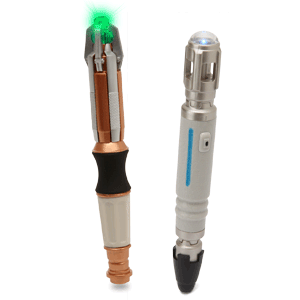A few months ago, when I was looking at putting together the website that I had been told to build for a while, I came to the decision that I had to somehow include a section for the general nerdery of my life. This would be the are with things that weren’t just based on work and my love of sound. While telling a friend about the site I was given the subject for the first post for this nerd section when he asked me to defend whether or not the famous sonic screwdriver from one of my favorite shows (Doctor Who) could in fact do the things that it gets used for in the show. Now, of course I recognize that Doctor Who is a science fiction show with the key point in the phrase being fiction, but let’s examine the science part of one of the most famous tools in the genre.
First, let’s explore the most common ways that The Doctor uses his sonic screwdriver in the show:
- Unlock doors
- Get into a computer system
- Scan the environment
- Scan his companions
- Fix broken equipment

Could the sonic screwdriver actually be used to perform all these actions? Well, the short answer is no it cannot do all of those actions, but if it were powerful enough, it could be used to perform a few of them. Many door locks involve hinges, screws, or other metal pieces that are designed to move. As the sonic screwdriver is generating a sound wave, if you could tune the frequency to a point where you might be able to vibrate the metal or gears involved that would then give you the ability to manipulate a lock. The idea of being logging into a secure computer system or fix broken equipment is a stretch. As computer security is code based, and while you could generate a pulse signal based in binary that might allow you access to something, that would require the computer system to be in some kind of a receptive state. Fixing broken equipment is not going to be possible either. While sound waves can generate heat at the point of origin, they cannot focus that heat to fuse or merge objects that have been broken. That leaves us with scanning his environment or his companions. Well, these would both be possible and currently part of our modern world, though not necessarily to the degree that they demonstrate in the show. Think about sonograms or sonar, both current technologies using sound to reflect off of objects to determine the location of things. This could simply be expanded upon in order to achieve the same goals that The Doctor reaches during the show. Think about the idea of him raising the sonic screwdriver and determining if there are dangerous chemicals in the air. Essentially what he is doing is transmitting a sound wave at a molecular level in order to determine what the density of the gases around him might be. Since gases all have different elemental weights and densities, then yes, theoretically this could be accomplished with something like a sonic screwdriver. By scanning a person (think Amelia Pond) to determine if there is something wrong with them, the same idea could be applied. The reflections of the sound would determine where an object might be located and what the density of the object might be. It’s all a matter of being able to interpret that reflective information, understanding what the cause of the reflections could be, and knowing how to analyze and apply the information.
So there you have it. Could a sonic screwdriver be used in the real world the same way the doctor uses it now? One day I’d like to think it will be a pure reality, but not everything he uses it for would be possible.

![doctor_who_50th_anniversary_by_stormy94-d6opgk7[1]](https://soundreason.org/wp-content/uploads/2013/10/doctor_who_50th_anniversary_by_stormy94-d6opgk71-210x300.png)


